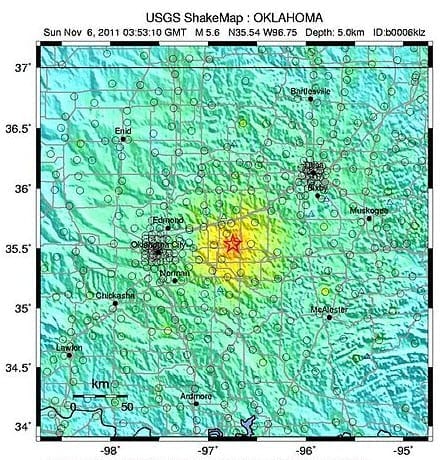 BOSTON, Nov. 7, 2011 – According to catastrophe modeling firm AIR Worldwide, on Saturday evening at 10:53 pm local time, Oklahoma experienced the strongest earthquake ever recorded in the state. With a magnitude of 5.6 and a focal depth of just three miles below the surface, the earthquake was centered about 44 miles east of Oklahoma City, the state’s capital and largest city (population 580,000 in 2010). A foreshock of M4.7 had struck 21 hours earlier. Together with numerous aftershocks, residents of Oklahoma were subjected to nearly two dozen earthquakes over the weekend.
BOSTON, Nov. 7, 2011 – According to catastrophe modeling firm AIR Worldwide, on Saturday evening at 10:53 pm local time, Oklahoma experienced the strongest earthquake ever recorded in the state. With a magnitude of 5.6 and a focal depth of just three miles below the surface, the earthquake was centered about 44 miles east of Oklahoma City, the state’s capital and largest city (population 580,000 in 2010). A foreshock of M4.7 had struck 21 hours earlier. Together with numerous aftershocks, residents of Oklahoma were subjected to nearly two dozen earthquakes over the weekend.
According to AIR, ground shaking from Saturday night’s quake was felt north into Kansas and Missouri, rattling windows and jolting people awake, and as far away as Wisconsin and South Carolina. In this stable intraplate region of the continental United States, ground motion decays more slowly with distance than in the western U.S. That is, for any given magnitude, the outward radiation of ground motion will cover a much larger area. The aftershocks recorded following Saturday night’s rupture are expected to continue for weeks-and potentially for months, though they will decrease in frequency. The aftershock activity of the last two days is not unusual for a magnitude 4.7 to 5.6 earthquake sequence.
According to local reports, the late-night rupture and other smaller quakes have not caused much damage or harm. The Oklahoma Department of Emergency Management has reported only two minor injuries attributed to the tremors, and neither injury was so serious as to require hospitalization. According to the National Weather Service in Norman, Oklahoma, its radar detected swarms of birds that took flight when the earthquakes occurred. Otherwise, the most serious damage reported so far has been two incidents: the fall of a spire from a five-story building (built in 1915) on the campus of St. Gregory’s University and the buckling of parts of local Highway 62 between the towns of Prague and Meeker. The road was repaired on Sunday.
Additionally, damage to at least 14 buildings has been reported, mostly from fallen chimneys and some interior breakage from dishes and other objects falling off shelves. There also has been one roof collapse and a municipal building ventilation system was damaged.
Earthquakes are not unusual in Oklahoma, but they often are too small to be felt. According to the United States Geological Survey, between two and six earthquakes were recorded per year during the period from 1972 to 2008. However, since mid-2009 the state has had ten times more earthquakes than its earlier annual average. Last year, 2010, Oklahoma experienced more than 1,000 earthquakes, although only about 100 or so were strong enough to be felt.
According to AIR, the magnitude 4.7 foreshock and 5.6 earthquake that occurred on Saturday-in the latter case a quake large enough to cause damage-are typical of the earthquakes that occur across large areas of the North American continent east of the Rocky Mountains. While earthquakes are not unknown in these areas, they occur in frequently. Also the Oklahoma earthquakes through the period 1973-2007 were scattered broadly across the east-central part of the state. The events since 2007, however, have been more clustered in the vicinity northeast and east of Oklahoma City-more or less the center of the state-and generally southwest of Tulsa. This is the area where Saturday’s magnitude 5.6 earthquake occurred. While further investigation will undoubtedly be undertaken, the likely source of the earthquake is the Wilzetta fault, which resulted from intraplate deformations dating back approximately 300 million years.
AIR continues to monitor seismic events in Oklahoma and elsewhere across the central United States, and will provide additional information if changes should occur. Insurance losses from Saturday’s quake are expected to be minimal.
